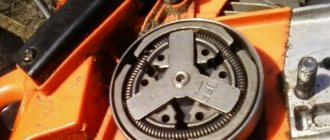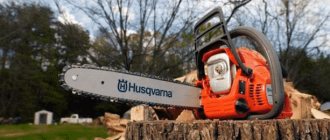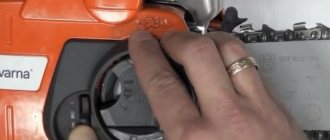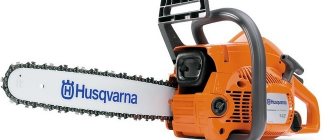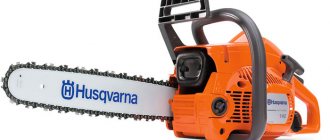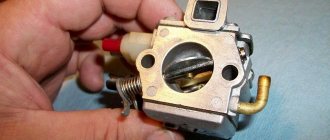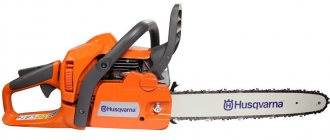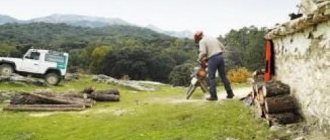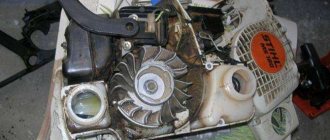Husqvarna saw disassembly algorithm
The process of disassembling a Husqvarna chainsaw is quite simple. In order to do everything correctly and not break parts of the housing or CPG, it is necessary to disassemble in the following order:
- Top cover.
- Chain and saw brake cover.
- Starter.
- Flywheel and clutch.
- Front handle.
- Carburetor.
- Oil pump.
- Engine.
Depending on the Husqvarna model, the disassembly procedure may vary slightly.
Important: before you start disassembling the chainsaw, you need to clean it. When working with a saw, a lot of chips and wood dust are generated, which during disassembly can get into the internal parts of the Husqvarna chainsaw
Removing the side cover and saw set
The side cover, or also called the saw chain brake cover, is held in place with two thirteen nuts.
After unscrewing the nuts, the cover is removed from the guide pins, after which you can remove the bar and chain from the chainsaw. Some models of Husqvarna saws have a special mechanism installed that allows you to dismantle the cover and saw set without the help of special tools.
Starter
The starter is located on the right side of the Husqvarna and is held in place by several screws. By unscrewing them, you can easily remove the starter and thereby gain access to the flywheel and ignition coil.
Removing the flywheel and clutch
In order to unscrew the flywheel nut, you need to unscrew the spark plug and install a piston stopper in its place.
Once the piston stopper is installed in the cylinder, the flywheel nut can be loosened. After the nut is unscrewed, it is necessary to use a hammer and a drift made of soft material to apply one sharp blow, installing the drift on the flywheel mounting shaft. This is necessary to remove the flywheel from the shaft, since the design provides for the installation and tightening of this element with great force.
You can learn more about how to properly remove the flywheel from a Husqvarna chainsaw, as well as how to completely disassemble the saw by watching the video. The wizard explains the entire process step by step and demonstrates all the necessary tools:
In order to unscrew the clutch you will need a special key. If there is no key, then it can be made from an old twenty-two head, grinding it in a certain way using emery.
Do not try to unscrew the clutch with a hammer and chisel, as some craftsmen advise. Using these tools, you risk breaking the clutch housing and increasing repair costs. It can also damage the crankshaft bearings.
Removing the Husqvarna front handle is quite simple, as it is attached to the shock absorbers with screws.
Air filter and carburetor
To remove the carburetor, it is necessary to disconnect the fuel hose and damper rods from it; this can be done conveniently after the air filter is removed, which is installed immediately behind the carburetor and held in place with two 10mm nuts. After the air filter is removed, the fuel hose and the rods are disconnected, just pull the carburetor towards you and remove it from the studs.
Oil pump
On Husqvarna, the oil pump is installed on the right side of the chainsaw. It can only be removed after the clutch has been released. Removal does not require a special tool, because... The fastening screws are made for a regular Phillips screwdriver. After the screws are unscrewed, it is necessary to lift the pump and disconnect the oil hoses from it.
Engine
To remove the engine on a Husqvarna chainsaw, after the carburetor, clutch, flywheel and muffler have been removed, you will need to unscrew the four screws securing it to the body.
After the engine is removed, you can unscrew the ignition coil from it, remembering to first disconnect the wires leading from it to the ignition switch. The coil can also be removed immediately after the starter is removed.
Assembling the Husqvarna chainsaw should be carried out in the reverse order, and the flywheel nut and clutch must be tightened with the force specified in the chainsaw operating instructions.
How to change the sprocket?
If you need to replace the sprocket on a Husqvarna 137 chainsaw, you will need to perform the following algorithm:
- Open the side cover giving access to the tire and sprocket.
- After loosening the chain, you need to remove the tire.
- Once the sprocket is free, unscrew the spark plug to gain access to the engine piston.
- You need to rotate the sprocket manually.
- The piston is brought almost to the highest point of the channel.
- The resulting hole must be filled as tightly as possible using a soft candle cord. This will block the movement of the piston.
- To unscrew the sprocket, use an open-end wrench.
Replacing the sprocket on a Husqvarna chainsaw is done as carefully as possible so as not to damage the mechanism components
Regardless of whether you repair the Husqvarna 137 chainsaw with your own hands or entrust this process to professionals, pay attention to the quality of the spare parts used
Chainsaw won't start
Why doesn't the chainsaw start, even if everything is done correctly, in accordance with the operating instructions? The working mixture is prepared in the required ratio, according to the requirements of the manufacturer, and poured into the tank. The air damper is closed to obtain a rich working mixture. Fuel was pumped up with a hand pump. The ignition is turned on with the corresponding button. Several vigorous jerks were made with the starter handle.
I would like to draw the attention of beginners to the process of starting a chainsaw. If everything is done correctly, then when starting the engine, the moment fuel enters the cylinder, additional resistance will be felt on the starter handle. It arises because when moving upward before igniting the spark plug, the piston pre-compresses the working mixture, and the resistance increases sharply
Based on this, we can already say that:
It arises because when moving upward, before igniting the spark plug, the piston pre-compresses the working mixture, and the resistance increases sharply. Based on this, we can already say that:
- Fuel enters the cylinder.
- The piston group is still alive and has some compression, the exact value of which we can only judge by measuring it with a compression meter.
Based on these conclusions, we can make the assumption that if there is fuel in the cylinder and the engine does not start, then the reason is probably the spark plug.
Assessment of the condition of the cylinder-piston group
Often the engine does not start or does not operate at full capacity due to low pressure in the cylinder. It can be caused by wear of the piston or cylinder, stuck piston rings, or worn bearings. You can partially examine the condition of the cylinder-piston group (CPG) by removing the muffler and looking into the opened hole.
A compression gauge placed in the spark plug hole will help measure the compression in the engine - based on the measurement results, we can also talk about the condition of the CPG. Accurate data is obtained only after complete disassembly of the mechanism. If the piston is chipped or scratched, it needs to be replaced. The piston ring must be clean, free of carbon deposits, and be exactly in place.
Wear of the piston and crank mechanism is considered a serious problem
Based on the results of compression measurements, one can judge the condition of the CPG parts
Guarantee of operational safety and easy start
The risk of injury in the event of an emergency is minimized due to the high-precision operation of the braking device, which is activated when the upper shield moves slightly in the frontal direction.
A manual starter with an easy start system, a booster pump and an advanced electronic ignition guarantee a successful start of the power unit in conditions of extremely low and high ambient temperatures.
Experts characterize the Husqvarna 142 saw as a fairly comfortable to use, productive, reliable and durable household tool that meets the requirements of modern technical and operational standards.
Ignition system
The work must be done very carefully. A special hook is used for this. First you need to disconnect the wire and remove the spark plug.
If it is dry, it means that fuel is not entering the cylinder.
If there is splashes on it, then the breakdown may lie in the carburetor or in the starting rule. To fix the breakdown, you need to wipe the spark plug and turn off the fuel supply. After this, the starter starts.
Thus, the combustion chamber is ventilated and excess fuel is removed. After this, the spark plug is installed in place and the chainsaw starts.
If there is carbon deposits on the spark plugs, this indicates that the Husqvarna 137 chainsaw runs on low-quality fuel. Carbon deposits also form as a result of an incorrect ratio of fuel and oil. In order for the tool to work as long as possible, you need to carefully study the operating instructions.
If there is carbon on the candle, it must be carefully removed. You can use an awl for this. The electrodes are carefully rubbed with sandpaper. After this, it is installed in place. You also need to fill in the fuel that is recommended for this model of chainsaw.
Read the article about repairing the Partner 350 chainsaw with your own hands here.
Model features
The Husqvarna 137 chainsaw is designed in such a way that all resources maintain maximum performance over a long period of time:
- The AutoTune option makes it possible to use automatic carburetor adjustments.
- When air enters, secondary filtration occurs, reducing the load on the filter.
- Vibration damping is due to the LowVib function.
- An easy start option is provided, thanks to which the engine of the Husqvarna 137 chainsaw operates uninterruptedly in any season.
- The chain tensioner is located on the side of the housing.
- For various, private adjustments and repairs, a universal key is used.
- The driven sprocket is equipped not only with an automatic lubrication system, but also with an auxiliary hole for receiving lubricants.
How to adjust the carburetor of a Husqvarna 142 chainsaw
Adjusting the carburetor of the Husqvarna 142 chainsaw should be done with the engine warm
Pay attention to the condition of the air filter, which will need to be cleaned if necessary and make sure it is not clogged. Adjusting the carburetor of the Husqvarna 142 chainsaw with your own hands is done using three screws:
- L – for low engine speeds.
- H – for high engine speeds.
- T – for idle speed.
Turn the low and high speed control screws clockwise to the limit, and after the peak is reached, turn them in the opposite direction, one and a half turns. When idling, the Husqvarna 142 chainsaw chain must be stationary. Check at maximum speed.
You can avoid most malfunctions and costly repairs by following the manufacturer’s instructions and recommendations, as well as using original spare parts for the Husqvarna 142 chainsaw.
The Husqvarna 142 gasoline saw is known to many users for its reliability, ease of operation, as well as the high quality of branded components and factory assembly. Garden tools in this modification quickly and efficiently cut down any wood, regardless of its condition and structure. This allows the model to be used not only for cleaning the garden, but also for the construction of domestic and utility premises.
Basic malfunctions and ways to eliminate them
When starting to repair a chainsaw, you need to have an idea of what malfunctions it may have, as well as how these malfunctions are eliminated. So, let's look at the signs of malfunctions and how to fix them.
Husqvarna chainsaw does not start
If the Husqvarna does not start, the first thing you need to make sure is that you follow the algorithm for starting the saw, as well as the presence of fuel in the tank. Detailed instructions on how to start a cold chainsaw and refuel it are available in the saw manual that comes with all Husqvarna chainsaws.
If you do everything correctly, but the saw does not respond, the reason may be a malfunction of the ignition system or lack of fuel supply.
To more accurately determine the reasons for this behavior of the chainsaw, it is necessary to inspect the spark plug, and then check it for the presence of a spark.
If the spark plug is wet and no spark is detected when checking, you should try replacing the spark plug itself. The replacement did not produce results, which means the problem may be hidden in the ignition coil, which is quite difficult to check on your own.
You can check the serviceability of the coil by installing it on a previously working saw of a similar model or by replacing the part with a working one.
If there is a spark, but the spark plug is dry, there is a problem in the fuel system. To eliminate it, you need to carry out a full diagnosis. The fuel system consists of a carburetor and a fuel line. Without any specific experience, you can check the fuel line for ruptures, as well as the cleanliness of the fuel filter installed in the tank. It is better to entrust complete carburetor diagnostics and repairs to professionals.
If the saw starts, but poorly
The cause of difficulty starting the saw may be a malfunction or incorrect adjustment of the carburetor. If the carburetor overflows, the chainsaw will be easy to start when hot, but quite difficult when cold, especially after a long period of inactivity.
An indirect sign of an excessive amount of fuel mixture entering the cylinder when the chainsaw is operating is the exhaust. If a lot of white smoke is emitted when the chainsaw is running, it is worth checking the proportions of the fuel mixture and carburetor adjustments.
Chainsaw chain spins at idle speed
If the Husqvarna chain rotates at idle, then we can conclude that there is a malfunction in the clutch mechanism or the idle speed is not adjusted. To eliminate the malfunction, it is necessary to remove the saw chain brake cover and inspect the integrity of the clutch spring. Replace defective clutch.
If the clutch is working properly, to eliminate chain spinning, it is necessary to adjust the idle speed using the adjusting screw marked with the letter (T) or carry out a full carburetor adjustment.
Important: a possible reason for an independent increase in idle speed is the appearance of air leaks into the engine crankcase or carburetor, which can lead to serious damage to the CPG.
Why does the Husqvarna chainsaw stall when you press the gas?
If the saw stalls immediately after pressing the gas, it is necessary to inspect the spark plug, which will help more accurately diagnose the problem. A wet spark plug indicates a malfunction or incorrect adjustment of the carburetor; in this case, the situation can be corrected by carrying out a complete diagnosis, repair and adjustment of this unit. If repairs and adjustments do not help, you need to replace the carburetor with a new one.
Another reason why a Husqvarna may stall when you press the gas is a malfunction in the fuel system, or more precisely, difficulty in supplying fuel to the carburetor. It is necessary to check the cleanliness of the fuel filter, as well as the integrity of the fuel hoses.
During the process of assembling the chainsaw during its complete repair, you can pinch the fuel hose coming from the tank to the carburetor, which will limit or completely stop the fuel supply and make the saw impossible to operate.
Why is the chain on the Husqvarna chainsaw not lubricated?
If your chainsaw has completely stopped supplying saw chain lubrication, then you need to check the entire oil system.
There may be several reasons:
- Oil pump malfunction;
- Clogged filter element installed in the tank;
- Oil tank breather malfunction;
- Oil hose rupture;
- Mismatches in the oil hole on the bar and on the saw body (if the supply stopped after installing a new saw bar);
- Clogged oil channel in the saw body;
- Clogged oil supply channel in the tire;
- Oil pump drive gear malfunction.
Self-repair of Husqvarna chainsaws is only possible if you have at least some knowledge about the operation of a two-stroke engine, as well as the principles on which the chainsaw is designed. As practice shows, it is not difficult to disassemble a Husqvarna chainsaw; it is much more difficult to assemble it without aggravating its malfunction. Calculate your strengths in advance and do not hope that you will be able to repair the saw without some experience. In some cases, even experienced technicians put a lot of effort into correctly diagnosing the problem.
The Husqvarna 142 gasoline saw is known to many users for its reliability, ease of operation, as well as the high quality of branded components and factory assembly. Garden tools in this modification quickly and efficiently cut down any wood, regardless of its condition and structure. This allows the model to be used not only for cleaning the garden, but also for the construction of domestic and utility premises.
Disassembly and Assembly of Husqvarna 142
BenzoTool. LIKBEZ
Disassembly. assembly of the HUSQVARNA 142 (137) chainsaw. Chainsaw STIHL MS180. Diagnostics of a complex of accounting programs for chain lubrication. Disassembling the PARTNER 352 chainsaw. Disassembling. assembly of the STIHL MS180 chainsaw. Disassembling the PRO WORK PBK 35 chainsaw. Compression in the STIHL MS180 and POULAN 2250 chainsaws. The principle of operation of a two-stroke engine. Chainsaw PARTNER 352. Disassembling the carburetor.
Disassembly. assembly of the HUSQVARNA 142 (137) chainsaw.
DISASSEMBLY OF THE HUSQVARNA 142 (137) CHAINSAW.
ASSEMBLY OF CHAINSAW HUSQVARNA 142 (137).
Hamster paradise. Go away and get lost:
Chainsaw STIHL MS180. Diagnostics of the chain lubrication accounting system.
Additionally, I’m posting two photos (because it wasn’t very clear in the video).
In this photo, the reddish arrow shows the collar.
The second photo shows the correct position of the oil pump (view from below the chainsaw). The reddish arrow points to the groove (channel) in the pump housing, the blue arrow indicates how the myth channel is placed. Reverse (towards the rear handle of the chainsaw).
Hamster paradise. Go away and get lost:
Disassembling the PARTNER 352 chainsaw.
Hamster paradise. Go away and get lost:
Disassembly. assembly of the STIHL MS180 chainsaw.
Disassembling the STIHL MS180 chainsaw.
Assembly of the STIHL MS180 chainsaw.
Hamster paradise. Go away and get lost:
Disassembling the PRO WORK PBK 35 chainsaw.
Honored guests of my blog! If you liked, and most importantly benefitted from, watching my videos and photographic materials on the repair of gas-powered tools, then I ask you to contribute whatever financial assistance you can to electric wallets:
WebMoney. R397899742942
or Z103294956413
The funds will be used to pay for servers, hosting, and a domain name for the development of the website. With respect to your apartment, Evgeniy Kravchenko.
What will you need? Chainsaw PRO WORK PBK 35. As I know. creation of Italy. Horizontal placement of the cylinder-piston group.
It came in for repairs with a problem that it wouldn’t start, and according to the owner’s words, the reason for this was supposedly bad spots on the piston.
I have never gotten my hands on a chainsaw of this model; alas, looking ahead, I will say that I liked the saw. The design is very, I would say, laconic, down-to-earth, nothing superfluous. We draw a conclusion. everything is made according to the mind
Adjusting the Husqvarna chainsaw carburetor
Like all other saws, Husqvarna has the same carburetor adjustment algorithm. Therefore, the instructions will be relevant for other tools and models of chainsaws such as Husqvarna 142, 236.
Before starting work, make sure the air filter is clean and all other components are working properly. The fuel supply to the float chamber should operate without interruption, and the ignition system is set correctly and has a fresh spark plug.
Procedure:
- Reset the carburetor to factory settings. This must be done with the engine stopped.
- Now you can start the engine and be sure to warm it up for several minutes. Adjustment of the XX carburetor Husqvarna 137 is carried out only on a warm engine.
- By rotating screw L clockwise, you need to set the crankshaft speed to the highest speed, then turn it back a quarter turn. Use screw T to adjust the crankshaft speed so that the chain does not rotate. It should not be driven without pressing the accelerator.
- Now you need to set the maximum speed and its power. It is enough to connect the tachometer to the ignition system and use the accelerator to set the maximum possible speed. Compare them with your passport data. If they differ, then unscrew or tighten screw H. By changing the range, you can create restrictions to make the saw work efficiently and save the life of the motor.
What you should pay attention to?
Once the adjustment of the Husqvarna carburetor is completed, you need to make sure that the engine is stable and that the saw easily picks up and drops the required speed. The rotation of the chain at idle is considered abnormal, so its connection with the clutch must be adjusted again using screw H.
Do not forget that the unit is not adjusted immediately: you need to wait some time, since the Husqvarna chainsaw does not immediately respond to changes in the position of the screws. This time can range from 5 to 15 seconds. This time is not indicated in the table, so you can only find out experimentally.
If after adjustment a huge amount of smoke appears during operation, then you need to adjust the supply of the fuel and oil mixture. For these purposes, rotate screw L.
What is the factory setting of the Husqvarna chainsaw carburetor?
To ensure that the chainsaw still starts even if the settings are incorrect, the factory positions of the screws H and L are used. Most Husqvarna chainsaws can be started if both screws are unscrewed exactly one and a half turns. Only after this can the screw positions be changed in order to achieve the desired fuel consumption and maximum operating efficiency. XX is also regulated after these manipulations.
If you still have questions about adjusting the carburetor on the Husqvarna 137 chainsaw and other models in this line, I recommend watching this video:
Carburetor adjustment
A separate section covers the carburetor adjustment sequence. Correct tuning of the fuel system contributes to stable traction characteristics and economical fuel consumption.
The work is carried out provided that the air filter is completely cleaned and the power unit is warmed up to operating temperature. By rotating the screws, quantity and quality, the engine is brought to optimal operating mode with good throttle response and stable idle speed.
Additional adjustment may be required when switching to fuel with a different octane number, or when switching the tool to winter or summer operating modes.
Fuel supply system repair
Fuel may not enter the cylinder for the following reasons:
- Fuel filter is dirty. You should remove the fuel hose and check how the fuel flows. If the stream is weak, the filter may need to be cleaned. It is taken out through the filler hole of the fuel tank and cleaned; in case of severe contamination, it is replaced with a new one. As a preventative measure, it is recommended to replace the fuel filter once every three months.
- Clogged breather (hole in the fuel tank cap). They also check by disconnecting the hose; if clogged, clean it with a needle.
- Lack or insufficient fuel. There may be several reasons for the malfunction. The first reason is a clogged air filter. Air stops flowing into the carburetor in the required quantity, and therefore, due to the fuel mixture being too rich, engine operation is disrupted. The dirty filter is carefully removed, cleaned and rinsed in water, then dried and replaced.
Another reason is incorrect carburetor adjustment. Adjustment is made with three screws.
Timely replacement of the fuel filter guarantees a complete fuel supply
The fuel hose and choke actuator must fit tightly to the fittings
The throttle cable must be in place.
During work, you must use the instructions, otherwise you can only make things worse.
And the last reason is a violation of the integrity of the membrane or clogging of the carburetor channels.
All parts must be clean, dry and in good working order.
Where to look for the reason or where to start checking
All chainsaws have the same design and work on the same principle. The structure of a chainsaw can be found in this material. It doesn’t matter much what brand the instrument is - Shtil, Husqvarna, ECHO, Champion, Partner, Sturm and others. A malfunction that manifests itself in the form of a chainsaw stalling when you press the gas can occur equally on both expensive and high-quality tools and on budget Chinese devices. If a problem arises, it needs to be solved.
A chainsaw is a system of mechanisms consisting of parts. Any part in the mechanism can fail, which will lead to partial or complete failure of the tool. If the tool’s engine starts, this does not mean that the chainsaw is fully operational. When the engine stops working when the speed increases, there are corresponding reasons for this.
In case of this malfunction, you should first pay attention to a number of the following tool mechanisms:
- Gas tank - make sure there is fuel. If there is sufficient fuel, you should also check the serviceability of the fuel filter, the connection of the supply hose to the carburetor, and also make sure that the breather is working
- Spark plug - if everything is in order with the fuel supply system, then you should check the serviceability of the spark plug. By the color of the carbon deposits on the spark plug electrodes, you can determine the cause of the breakdown. If the carbon deposits are brown, then the spark plug, ignition and fuel supply system are operating in the correct mode. The presence of black carbon deposits indicates an ignition malfunction, and if the electrodes are wet, then the carburetor should be checked
- Muffler - over time, carbon deposits accumulate in the exhaust gas removal device, which helps reduce the throughput of the mechanism. If the exhaust gases have nowhere to go, they will interfere with the normal operation of the engine. In addition to a decrease in power, if the muffler is faulty, the engine will stop working when the speed increases
These are the main parts and mechanisms that should be checked first if a malfunction occurs when the chainsaw stalls when the accelerator is pressed. There are other reasons why a chainsaw engine stalls when the gas trigger is pressed. What else can contribute to the occurrence of this malfunction, as well as the specifics of troubleshooting, we will find out further.
Why does the chainsaw stall?
If the chainsaw starts and stalls, the reasons may be different. An external inspection should be carried out before attempting to repair the instrument.
If the saw stalls during operation, you should check the presence of a mixture of oil and gasoline in the tank. If the fuel mixture runs out, the device will not work. In situations where there is still gasoline left, you should evaluate the quality of the tool before turning it off. The appearance of extraneous sounds and the subsequent sudden stop should alert you.
The formation of carbon deposits on the electrodes can also cause difficulties in the operation of the tool. You should carefully inspect the device and clean it if necessary.
When you press the gas
In cases where the chainsaw stalls when you press the gas, you should check the muffler and fuel filter. A possible cause of the problem is a leak in the fuel hoses. In some cases, adding speed helps.
Sometimes checking all the details does not give results, the tool suffocates, chokes when gas is added. If the device stalls when a person presses the gas, it is possible that the fuel supply is insufficient for normal operation. This phenomenon occurs due to a clogged carburetor or filter.
Damage can also occur due to the air filter becoming clogged with dust. When you give gas, the device stops working. You should not fix the problem yourself, since each model has individual characteristics.
The problem may be caused by insufficient or lack of lubrication on the chainsaw chain. If the chain is dry, you should clean the channels through which oil is supplied to the device bus. If the oil leaks, there are cracks and defects in the pipes, they need to be treated with sealant.
Under load
In situations where the device stalls under load, the problem may be with the gas tank or filters. Check the fuel quality and change the filter.
Often the saw does not gain speed due to the fact that the mixture poured into the gas tank has a low octane number. There is not enough power, sufficient heating is not possible, the chainsaw stalls under load.
Often, malfunctions of components lead to the device stalling under load. Hoses, seals, and gaskets should be checked for leaks. If parts are faulty, you can try to repair or replace them.
In cases where the chainsaw starts and immediately stalls, there is not enough fuel, the device does not heat up. The device must be recharged
It is important to use the correct mixture. Different types of fuel are better suited for different models
It is necessary to read the instructions, recommendations, reviews of people for whom the device works normally
It is necessary to read the instructions, recommendations, reviews of people for whom the device works normally.
Idling
In situations where the chainsaw stalls at idle, you need to inspect the condition of the muffler. If the part is dirty, exhaust gases are poorly removed, the engine cannot continue to work and stops.
The saw stalls at idle and in cases where the carburetor is not configured correctly. For beginners, it is better to entrust the repair to specialists, since there is a possibility of incorrect settings, due to which the tool will not be able to work. A tachometer is required to adjust the carburetor.
At high speeds
If the device stalls at high speeds, pay attention to the condition of the gasoline and air filters, the serviceability of the fuel hoses
A dirty air filter can be washed under warm running water.
It is important to thoroughly dry the part before installing it so that water does not damage the serviceability of the tool.
If fluid stops flowing through the fuel hose, it is clogged. You can clean the part or replace it with a new one.
In cases where the saw stalls at high speeds, but the liquid completely flows through the hose, and the air filter is clean and in good working order, look for the cause of the breakdown in the fuel filter. Replace it with a new one or clean it.
In some cases, the problem is hidden in the gasoline pump. When a component wears out, fuel begins to leak through the walls. If this phenomenon is observed, a new pump should be installed.
When tilted
If the saw does not develop speed when tilting, turns off, or stops working, you need to check the fuel level in the tank. If it is not too high, the device in an inclined position is not supplied with sufficient fuel, since the fuel pipe is above the mixture level.
Recommendations for replacing the clutch on a chainsaw
In addition to the basic operating rules described in the previous section, it is worth remembering some nuances when replacing the clutch. Use only original manufacturer parts - this is the key to long and productive operation of the tool. The clutch thread on all chainsaws of any manufacturer is always left-handed. Before removing the coupling, carefully remove all dirt and dust from the tool so that it does not get inside. When reassembling, do not forget to replace all small parts, including washers and bearings. Make sure to install the special spring (not all chainsaws have it) - if it is installed incorrectly, oil will not be supplied to the saw bar.
A chainsaw for a business man is an indispensable tool that comes to the rescue when performing logging work of various sizes, implementing construction projects from timber, landscaping private properties, a garden, a yard, and on a farm.
The power unit consists of several important components, including the clutch. Often, the tool may malfunction due to a faulty chainsaw clutch. This is a typical breakdown that chainsaw owners encounter, regardless of its class, power, model and manufacturer. To repair the clutch, or at least accurately diagnose the cause of the failure, operators need to know how to unscrew the clutch on a chainsaw. This knowledge will allow not only to carry out forced repair work, but also scheduled cleaning and inspection for preventive purposes. Do not forget that the clutch and its serviceability affect the long and efficient operation of the tool.
Chain brake
A problem with the chain brake may occur due to lubricant or sawdust getting into the system. Here you need to clean all the elements from debris. In addition, the tape may become unusable and then it needs to be replaced.
It happens that some parts of the saw become unusable more often than others, so they will have to be repaired more than once. Most often this is a tire, drive sprocket, chain, anti-vibration parts. To quickly repair and assemble the device, you should always have spare parts on hand.
Causes of chainsaw malfunction
If the chainsaw does not start, then you need to carry out step-by-step diagnostics. It is recommended to go from simple to complex and do everything in order. Although devices from different manufacturers differ from each other, they have the same operating principle and layout: they are based on a two-stroke gasoline engine, which rotates a tensioned cutting chain through a gearbox.
Diagnostics must be carried out sequentially:
- Inspection of filters.
- Checking the electrical system (is there a spark at the spark plug electrode or not).
- Inspection of the fuel supply and breather, which is built into the fuel tank cap.
- Study of exhaust gas channels.
Each of the four stages must be considered separately.
What you will need for repair:
- Set of car wrenches, sockets and sockets.
- Screwdrivers: Phillips and slotted, flat spatulas for cleaning parts.
- Metal brush (cord brush) and brushes with hard bristles.
- A basin for washing parts (a cut plastic canister will do).
It is recommended to use a compressor to blow through engine parts. The use of technical gases (especially oxygen) is prohibited.
Filters
Dirty filter on a chainsaw If the chainsaw has been running for a long time, it is possible that the air or fuel filters may become clogged. In the first case, the required portion of air will not enter the cylinders, and combustion of the fuel mixture will not occur. If the fuel system is clogged, the supply of gasoline mixture will stop.
The air-cleaning element should be removed carefully; dust should not get into the carburetor. The element needs to be blown out, washed with soap and water, dried and then reinstalled.
To check the condition of the fuel filter, you need to remove the hose from the carburetor and try to pump fuel manually. If the stream is too weak or completely absent, the filter needs to be replaced or washed. You can purchase a new one from a dealer, or go to a power tool repair shop.
Checking the spark plug
It may be necessary to install new spark plugs. The operation is similar to that carried out by all motorists with gasoline engines. If you have a new and 100% working spark plug in stock, then the easiest way is to install it and try to start the chainsaw. The old one should be inspected: heavy carbon deposits indicate that the engine is not working properly. If there are no deposits, the gap between the electrodes may have broken down, causing the spark to stop forming or to be too dim. The distance between the contacts varies between 0.2-0.5 mm.
Why does carbon deposits form:
Errors made when adjusting the carburetor.
Added too much oil to the mixture.
The air filter was clogged.
The verification algorithm is simple:
- Remove the high voltage wire.
- Unscrew the spark plug and attach the previously removed wire back to it.
- Place the spark plug skirt against the unpainted part of the cylinder.
- Try to start the engine.
You can try to disassemble the ignition unit, clean the contacts, dry it, reassemble it and try again. A number of faults cannot be eliminated, so in some cases the unit will require replacement, but this is a last resort.
Gasoline supply. Breather
Breather One of the most difficult stages of testing.
First you need to prepare your workplace:
- Remove dirt and dust from the workbench.
- Prepare clean rags, brushes, containers for washing small parts.
- If you have a compressor, prepare it to blow through the carburetor channels.
The chainsaw itself needs to be cleaned and blown with compressed air. Now you can start diagnosing.
Check status:
- Fuel tank - there should be no dirt, iron filings, sand or other impurities inside.
- A breather built into the lid - air must enter the tank through it, otherwise a vacuum will be created during operation and fuel will not flow into the carburetor.
- Hoses and tubes - for cracks and other defects. Replace if in any doubt.
After assembly, you need to check: if, as a result of manual pumping with the supply tube removed from the carburetor, the gasoline mixture flows in a dense stream with jerks, then the system is working. If the chainsaw still does not start, then the carburetor is to blame.
Exhaust channels
It may be necessary to clean the exhaust channels on the chainsaw. After prolonged use, the exhaust channels of the chainsaw may have become coked, causing resistance to the forward movement of the piston. Simply put, gases that are not removed slow down the engine.
How to fix:
- Remove the chainsaw muffler.
- Carefully remove the gasket.
- Remove the spark arrester.
- Disassemble the resonator housing (if possible).
- Clean parts using cleaning solutions (kerosene, WD-40) and mechanically.
- Wipe and dry the knots.
- Put the system back together.
Repair Husqvarna 142 Do It Yourself Video
Do-it-yourself repair of Husqvarna 142 chainsaws
Why you need to tune your Husqvarna carburetor
The carburetor is one of the important mechanical components that make up a chainsaw. In his tasks. mix fuel with air and feed the resulting composition into the engine. But during the operation of the chainsaw, situations arise when adjusting the Husqvarna carburetor becomes necessary. Depending on the reasons, the carburetor adjustment of chainsaw 142 and other series is performed to prevent the following situations:
- the presence of interruptions in engine operation, accompanied by its shutdown;
- excessive fuel consumption during operation.
Since the carburetor affects the quality of the fuel, in the first case the need for carburetor adjustments on the 137 saw or other professional series such as the Huskvarna 240 or 260 involves affecting enough combustible raw material entering the carburetor to mix with the air mass. It is known that maximum performance is possible only with a certain ratio of these substances. The second point in adjusting the carburetor mixer chainsaw is due to the lack of incoming air, which causes underheating of the injected gasoline and its output in the form of thick smoke. Timely changing the parameters with your own hands to reduce the amount of introduced fuel will significantly reduce the consumption of this product.
The repair itself will save not only the budget, but also the time spent on transportation and the queue in the workshop. The same applies to replacing various spare parts in a gasoline tool, such as a chain on a chainsaw or a universal trimmer head on a motor pump or oil for electric drives.
When you need to adjust your Husqvarna carburetor chainsaw
Neglecting deviations in the normal operation of a gasoline tool risks the fact that even with a strong desire, adjusting the carburetor of a Husqvarna chainsaw may be useless, and it will be necessary to replace either this unit or engine components subject to prolonged thermal or mechanical stress. Therefore, as soon as the saw shows the first deviations, it is necessary to carry out immediate repairs in the form of simple corrective actions. Among these changes in work we note:
- The chainsaw slows down too slowly;
- The tool does not reach maximum power and falls quickly when loaded;
- The engine stops frequently;
- The chain saw makes a lot of noise when operating;
- The chainsaw releases an uncharacteristic amount of smoke, increasing at each stage of load.
Technical and technological features
To increase productivity, operational reliability and durability, higher quality materials are used in the production of the chainsaw range. Also experience in successful implementation of past developments, own design solutions.
Only by purchasing the original can you have full confidence that the power and other properties of the Husqvarna chainsaw model 142 will cope with transverse, diagonal or longitudinal sawing of all types of wood up to 30 cm in diameter.
- These characteristics determine the suitability of the tool for harvesting wood fuel, cutting timber, and forming crowns of ornamental and garden trees.
- The ability to operate the saw with tires that are smaller and more comfortable for working in inaccessible places determines the suitability of the tool for the construction of wooden structures for special and general purposes.
- Working with a saw does not require professional qualifications; the necessary abilities are quickly acquired during the work itself.
The design and principle of operation of the Husqvarna carburetor
To successfully configure the Husqvarna chainsaw carburetor, you need to know its structure and understand how it works. In fact, everything is not as complicated as it seems at first glance.
The saw carburetor has a built-in fuel pump, which is responsible for transporting the mixture of gasoline and oil, as well as a diaphragm, a needle valve with a rocker arm. Their joint work makes it possible to dose the fuel supply to the main chamber and two dampers.
One of the dampers is designed to regulate the flow of fuel into the cylinder when you press the gas, it is called the throttle, the second is responsible for limiting the flow of air from the air filter to facilitate starting a cold Husqvarna chainsaw. At the moment when the operator shuts off the air supply to the carburetor using the air damper, the fuel mixture becomes leaner and its supply to the cylinder increases, due to which the chainsaw starts much easier than when a cold start is carried out in normal mode.
The operation of the Husqvarna carburetor involves a valve-nozzle, which atomizes fuel and prevents air from entering the main chamber. Often problems with saw operation can be caused by defects in this particular element. For example, if the chainsaw is stored improperly, the valve may stick, the fuel supply will stop, which will make the engine impossible to operate. Also, malfunctions in the operation of the nozzle can cause air to leak into the main fuel chamber of the carburetor. In such cases, adjusting the position of the adjusting screws will not correct the situation; repair or replacement of the unit will be required.
Three adjusting screws installed in the carburetor body are responsible for adjusting the quality and quantity of the mixture, as well as the number of crankshaft revolutions in idle mode:
- screw (L) – regulates the amount of fuel in low and medium speed modes;
- (H) – responsible for traction at high speeds and their number;
- (T) - changes the position of the throttle valve, thereby regulating the amount of fuel mixture entering the cylinder and the operation of the tool engine in idle mode.
Husqvarna-236
This model replaced the much-loved 137.
Having slightly less power (1.4 kW), it added 100 g in weight, gained a 40-centimeter saw bar and, most importantly, a new engine, 20% more economical than its predecessor, with higher torque and a wider speed range, which did the job with this saw it is even more comfortable and has slightly expanded the range of its applications.
True, its cost has increased somewhat and today amounts to almost 11 thousand rubles, but if you recalculate to the current dollar exchange rate (and these saws are produced in Sweden and the USA), then everything will fall into place.
The device of the Husqvarna 142 chainsaw
One of the main advantages of the 142nd model of the Swedish brand Husqvarna is the competent selection of its components and the high quality of the original assembly. The basis of the garden tool consists of a 2-stroke gasoline engine, the chrome-plated cylinder of which has a volume of 30 cm3. Starting a standard internal combustion engine is done by pulling the recoil starter cable. A proprietary Japanese Walbro brand carburetor with forged jets and an improved fuel injection system is responsible for preparing and enriching the fuel mixture with air in the internal combustion engine configuration. The manufacturer equipped the engine with a fuel and oil tank with a volume of 370 and 190 ml, respectively.
The Husqvarna 142 chainsaw is equipped with a durable clutch, which is responsible for the continuous connection of the engine with the saw set. All spare parts of the mechanism are made of durable steel, resistant to high temperatures and corrosion.
For instant ignition of fuel in the internal combustion engine cylinder of Husqvarna garden tools, a proprietary capacitor ignition system is used, which includes a Champion RCJ7Y spark plug. The distance between the flywheel and magneto electrodes in the operating state of the ignition system is 0.5 mm.
